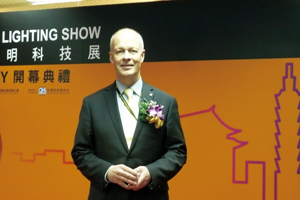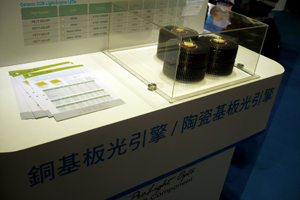An Interview with Jan W. Denneman, Head of GLA and Zhaga
“If light engines are not interchangeable, LED lighting will be very diverse and grow very slowly. Most of all,
2012/05/23 | By Ken LiuJan W. Denneman, president of the Global Lighting Association (GLA) and chairman of the Zhaga Consortium, as well as a VP with Philips Lighting, announced at the opening ceremony of the Taiwan International Lighting Show 2012, which took place on March 13-16, that the Global Lighting Forum (GLF) had changed its name to the Global Lighting Association (GLA) and that the Zhaga Consortium would produce three to four interface standards for LED light engines at an annual meeting on the sidelines of the show.

GLA was established in 2007 to represent national lighting associations worldwide and promote the use of sustainable, energy efficient lighting solutions while maintaining and improving lighting quality. The group's membership currently consists of the European Lamp Companies Federation, Lighting Council Australia, National Electrical Manufacturers Association (NEMA) of the United States, China Association of Lighting Industry, Taiwan Lighting Fixture Export Association, Japan Luminaires Association, Japan Electrical Lamp Manufacturers Association (JEMA), Associacao Brasileira de Industria de Iluminacao (Abilux), Electrical Lamp and Components Manufacturers' Association of India, Korea Institute of Lighting Technology (KILT), and the EU's Federation of National Manufacturers Association for Luminaires and Electrotechnical Components for Lumiaires (CELMA).

Founded in 2010, Zhaga is a consortium of individual companies working together to develop standards for LED light engine interfaces so that engines from different suppliers can be interchangeable in different lighting fixtures. So far, the alliance has introduced interface standards for spotlight and downlight engines as well as indoor light engines equipped with electronic control gears from different suppliers. Heavyweight members include Philips Lighting, Osram, Samsung Electronics, Epistar, Sharp, Toshiba, GE, and Everlight Electronics.
In an interview with CENS Lighting magazine, excerpted below, Denneman elaborated on the name change and the need to set interface standards for LED light engines:
Q: Why was the GLF renamed GLA?
A: Because we are now a mature organization and want to become a real association of important national associations. Our over 5,000 members now represent over 85% of the world lighting market, with total sales of approximately 50 billion euro. Also, the change signifies the technological shift of the lighting industry from the classical analog type to digital LED. So, we think the organization needed to be changed into a formal association. What the association will do is share knowledge on global trends, legislative developments, and opportunities in lighting.
Q: You are head of both GLA and Zhaga. Is there any linkage between the two?
A: GLA works with all kinds of organizations like Zhaga, CIE, and the International Solid State Lighting Alliance. Zhaga has a limited scope, focusing on standardization of LED light engines. But GLA has much wider scope of tasks, including promotion of standardization, harmonization of lighting legislation, consumer education, and customer expectations.
Q: Why did Zhaga choose to standardize light engines, but not other LED devices like chips, epiwafers, or even phosphor?
A: LED standardization is not easy, and it's unnecessary on the chip level. But it is easier for light engines. It is just like a fluorescent lamp; you do not standardize the phosphor inside, you standardize the lamp. So that's why we standardize not LED devices but light engines.
Q: You have hundreds of members in both organizations. How do you coordinate among them to produce standards for the LED lighting industry? Don't they develop disagreements when standards are being drafted up?
A: Zagha now has over 180 corporate members. Usually, when a light engine becomes a standard, the members begin to strive for the best possible solutions to interface the engine. Sometime, it is tough because you have to debate a long time before coming to a conclusion. If you do not come to a conclusion, you have no standards. Sometimes, company A wants to go right and company B wants to go left. When they ultimately come to an agreement, the standards come out.
Q: LED is a very dynamic lighting technology that is evolving very quickly, which means that today's standards might become out of date later. How do you set standards for a technology that is still evolving?
A: We don't standardize light engines; we standardize the engines' interface. If you have a luminaire that adopts a Zhaga-led interface standard for light engines, you can always replace the engine you're using with another under the same interface standard. The engines always have new technology in them. So we cannot set standards for the engines, but for the interface. A standardized interface always allows new-generation engines to be interchangeable on luminaires.
Q: Does that mean the interface is easy to deal with in standardization work?
A: Easier, not easy, compared with other devices. So, Zhaga has hard work. It meets three times a year for three days; and during the meetings, corporate members are busy doing technical work to develop interface standards. So Zhaga's members invest a huge amount in creating the standards.
Q: How important is standardizing the LED lighting industry? If Zhaga were not setting interface standards, how would the industry be affected?
A: The industry would be very diverse and grow very slowly. Most of all, confidence in LED lighting would become less. My company, Philips, has noticed that if light engines are not interchangeable, our customers will be hesitant to invest in luminaires.
Q: Many general lighting technologies were developed before LED, and most of them are governed by standards. Does that make the setting of global standards for LED lighting easier or harder than it was for existing commodity lighting technologies?
A: Fluorescent lamps and HID lamps are two typical commodity lighting markets worldwide. But luminaires for these two categories are very different from country to country, or from region to region, because of different specifications or standards that are limited to each country or region. But LED luminaires have become more and more global because LED devices and interfaces are becoming more and more global.
Q: How many interfaces has Zhaga standardized, and how many will it standardize in coming years?
A: We will publish three or four standards for spotlights, general lighting, and downlights this week. For an organization that opened only two years ago, that is not easy.
Q: GLA accepts national associations as members, whereas Zhaga accepts individual corporations as members. Why the difference?
A: You can develop standards only with people in design process. So, Zhaga needs companies developing the engines and using the engines for its standardization work.
GLA represents national associations, so it talks more about government policies, advice on government regulations, harmonization of minimum lighting performance requirements of different countries, and standardization of measurement methods. We advise standards organizations on what standards need to be developed. We do not develop standards in GLA, but delegate the work to Zhaga, IEC, or CIE.
Q: This year, what will be at the top of the agenda for GLA and Zhaga annual meetings?
A: In Zhaga, this year we'll continue with standards for interfaces for downlights, general lighting, and spotlights. In GLA, we'll focus on education addressing consumers' realistic expectations of what LED can and cannot do. Also, we will focus on stressing the greater benefits of LED compared with other lighting technologies. LED saves a lot of energy, which in turn saves consumers a lot of money and trims a lot of CO2 emission for the earth. Of course, fewer emissions make the earth sustainable.
There is much more you can do with LED today than before. More evidence has proven that lights deliver a huge biological effect on the learning ability of children and adults. Lights can influence your mood and your effectiveness in office and factory. They can improve driving safety tremendously, and the feeling of safety in cities. Basically, what we want to do in GLA is to upgrade lighting from a pure commodity business into an interesting business.
So, lighting is just at the beginning of a new age in which lights can do more than just make things seen or be seen themselves.
Q: What's your personal outlook for the LED lighting industry this year? People say the 2011 collapse of the LED backlight market gives a boost to the lighting market because it has made LED prices much lower than before. Is that what you think?
A: I think that [the price collapse] will indeed help. Quality retrofit LED lamps for households are still a little bit costly. If the cost comes down, the penetration of good LED lamps will increase hugely.
Q: How fast do you think the LED lighting market will grow worldwide this year?
A: I think 20% this year.
Q: What is Philips' plan for its LED lighting operation in the coming years?
A: We believe that in 2015 and 2016, LED lighting will become a major part of this company. It already accounts for over 20% of sales, and we believe it will grow to 30, 40, and 50% in the coming few years.
Q: Could you predict price trends in the LED lighting market?
A: It's difficult to say now. But it is a general tendency that LED manufacturing costs are going down, efficiency is improving, and production is growing toward economic scale. These tendencies will continue over the next few years. At this moment, prices of LED lamps still stay high because quality must be secured. (April 2012)




